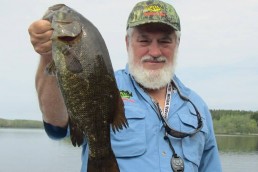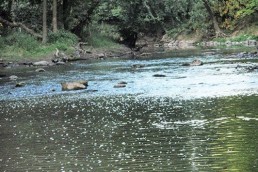Take Smallmouths on Crankbaits for More Fun
SHARE THIS POST
May is one of my favorite months for trying to catch some lovely bronze-hued, hard-fighting, high-leaping smallmouth bass. Does it sound as though I like smallmouth fishing? You better believe it. For me, it has become a passion. As with many streams of northwestern Ohio, my two favorites, the Ottawa and the Auglaize, both that slowly find their way northward toward the Maumee and into Lake Erie, run high, brown and muddy after heavy rains in spring—and 2016 has not been an exception.
But by mid-May, the streams are running clearer and the fish are biting. The only two problems with late spring and early summer are the humidity and lower water. Each can be dealt with and fish can be caught.
As for the humidity, whenever possible, opt for hip boots rather than chest-high waders. With lower water levels, this should reward the angler with easier, cooler wading. Tie a stout staff to your belt, and when in doubt about the depth of the water, do not take chances and probe ahead with the stick. Wear a short-sleeved shirt and slap on plenty of sunscreen to avoid sunburn. I like to wear cotton trousers or cut-off shorts rather than wearing blue jeans.
Lower water is problematic to the occasional angler, but it really can be a blessing in disguise since it tends to “concentrate” the fish. If the fish are not in the shallows as they are in times of high water, they have to be in deeper water. And since the deeper water is in the pools, holes, and narrow stretches of the river, search until you find deeper runs and then dredge them with plastic crankbaits until you find what the fish prefer.
Two crankbaits immediately come to mind: those that imitate crawdads and those that imitate minnows. These are two items high on the smallie’s food chain this time of year.
Bear in mind that deep water this time of year may be no more than 5 feet, so begin your search with short-lipped models that run 2 to 3 feet in depth. Choose natural colors in browns, greens and reds that imitate the color phases of these small crustaceans.
Are you enjoying this post?
You can be among the first to get the latest info on where to go, what to use and how to use it!
If riffles are present in the river, make your first casts—upstream, naturally—at the base of the riffle where there should be some fish waiting for the current to tumble a few tasty crawdads in their direction. No takers? Tie on slightly deeper-running crankbaits and dredge the run just below the riffle. Still nothing? Move up to the water just above the riffle and make casts across the stream. Concentrate on any isolated boulders and bring your lure past them in every possible direction. Do not be afraid to bang your lure off the boulder itself. More often than not, this will trigger a strike from a non-aggressive fish.
If crawdads fail or if you have caught so many fish that you want to try something different, switch to a minnow lure such as the original floating Rapala, the Storm Wart series, a Rebel Wee-R or the effective Yo-Zuri L Minnow. The L Minnow comes in a variety of finishes, but I never have found one that is more effective than the Rainbow Trout color. It features a subtle internal rattle with a good action that combines flash, sound and vibration—just the thing for river bass.
Try the same types of water where you fished the crawdad; only try varying your steady retrieve with an occasional stop and go action. Let the fish tell you what they prefer, look for laydown trees and riprap, make parallel casts to both and be ready for an arm-wrenching jolt. Keep in mind this is a sinking lure, and if snags are present, you might want to switch to a floating diver such as the Rapala.
Always remember that smallmouths are natural-born followers. Retrieve your lure right up to where you are standing in the water, then turn slightly and run it for a ways past yourself. There is nothing on earth like the thrill of a red-eyed, ornery smallie busting your crankbait just as you are ready to lift it out of the water. Set your drag just a bit loose and be ready for a fight.
MWO
SHARE THIS POST
Did you enjoy this post?
You can be among the first to get the latest info on where to go, what to use and how to use it!
John Bennett
John Bennett is a retired history teacher, historical re-enactor, father and grandfather. As a four-season outdoorsman, his passion is waterfowl hunting and fishing for smallmouth bass. He lives in Ohio and spends quite a bit of time in his primitive log cabin, which he built.



